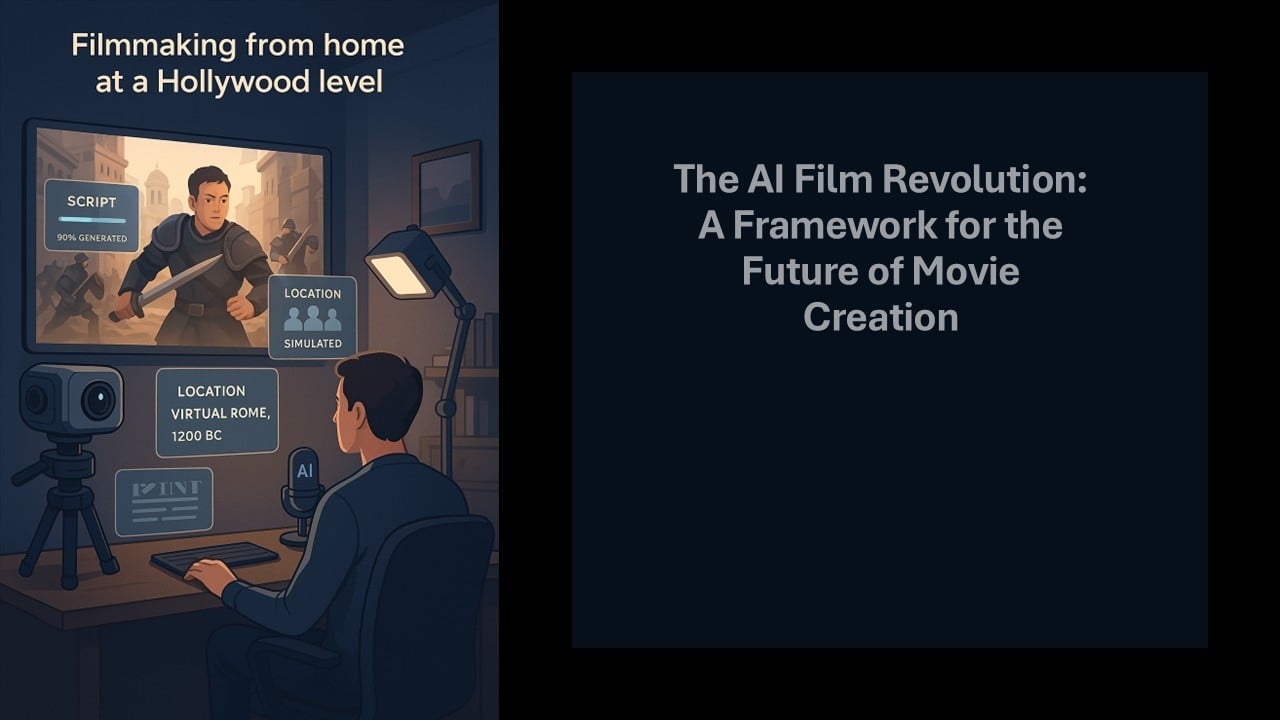We all see it. The unstoppable rise of AI video creation applications. Every week, we come across another viral deepfake, another app cloning human faces, voices—even entire personalities. The line between real and fake blurs more and more. It’s exciting. It’s terrifying. It feels like magic, and sometimes like a warning.
Every day, there’s something new—an AI that can animate still photos, create short films from text prompts, or mimic the voice of someone who passed away decades ago. You might ask yourself: Where are we going? Where is the end? Or… is there even an end?
We must come to terms with something important: AI is not a wave—it’s a tide. It’s not like other technologies that peak and fall. AI is a continuous force, evolving layer by layer. While some applications will surely vanish—those that can’t keep up or serve no real need—others will grow stronger, more powerful, and more integrated into our lives.
And among the industries most likely to feel AI’s deep impact is the one we’ve loved for over a century: cinema.
This article isn’t about what AI can do right now—it’s about what it will do in the next 3 to 5 years. Not a list of current tools or trends, but a forecast, a human-centered vision of how the world of movie-making could—and most likely will—transform. Not just for filmmakers. For everyone.
What if you could create a movie from your living room? What if you could star in it, direct it, write it, and bring in your favorite actors from the past—or even your friends and family?
I believe this is not science fiction anymore. This is the dawn of the AI Film Era.
Important note: This is mainly forecasting based on the current trend of AI, also we covered some of the areas across the filming industry not all. Future might hide a lot!!! , we still really not exactly sure of the AI trend ....
1. AI-Powered Equipment & Intelligent Production Tools
While much of the current conversation around AI and filmmaking focuses on software—like text-to-video apps or voice cloning—there’s a parallel revolution happening behind the scenes: the rise of AI-integrated filmmaking equipment.
We’re entering an era where the tools themselves become intelligent collaborators. Cameras, microphones, lights, and even mobile devices are evolving into robotic assistants, blending artificial intelligence with physical hardware to offer real-time guidance, precision, and automation on a level we’ve never seen before.
1.1 Robotic Cameras: Smart Eyes on Set
Cameras will no longer be passive recorders. Future AI-powered cameras will:
- Recognize body language, human movement, and facial expressions with precision.
- Automatically track actors or creators, adjusting focus, zoom, and framing dynamically.
- Guide creators with real-time suggestions like “shift left for better composition” or “deliver that line again with more intensity.”
- Replace green screens with AI-generated environments in real time, using only motion data.
Whether you’re a solo creator or a small team, your camera will feel like a director’s assistant—reading the room and enhancing your creative intent.
1.2 Smart Microphones: Perfect Sound, Instantly
Microphones will go far beyond recording. They will:
- Auto-correct vocal tone, pitch, and pronunciation as you speak.
- Eliminate background noise and clean audio live.
- Adapt voice delivery based on the emotion of the scene—sounding more dramatic, calm, or excited.
- Translate voices in real-time while keeping the speaker’s original tone and personality. Voiceovers, dubbing, and sound engineering will be handled seamlessly, often without the need for post-production.
1.3 AI-Driven Lighting: Cinematic Vibes on Autopilot
Lighting will become dynamic and emotion-aware:
- Lights will adjust themselves automatically depending on the scene—warmer for romance, harsher for action.
- They will coordinate with the camera and microphone to maintain a cinematic mood throughout the shoot.
- Even household lighting systems could be used in filmmaking, transformed into smart studio lights with AI-enabled adapters.
No more light setups, no more gaffer teams—just press record, and let the lights choreograph themselves.
1.4 Mobile Devices Become Mini Studios
Yes, it will move to our mobile phone , smartphones will become AI-powered studios in our pockets:
- With robotic mounts, 3D scanning apps, and motion-aware recording tools, phones will capture studio-quality footage.
- AI plugins will enhance videos in real time, track movements, and apply visual effects on the spot.
- Mobile devices will feature apps that act as directors, editors, and cinematographers, supporting creators from shoot to post-production.
1.5 From Million-Dollar Rigs to Affordable Creativity
Traditionally, making a high-end film required:
- Motion capture suits (MoCap) with dozens of sensors.
- Complex CGI pipelines and expensive rendering software.
- Dedicated hardware, data centers, and large technical teams.
With AI, all of this changes:
- MoCap suits will become obsolete, replaced by vision-based tracking from smart cameras.
- Rendering becomes instantaneous with AI upscaling, auto-texturing, and procedural environment generation.
- What used to take weeks and cost millions will be possible in real time, on consumer-grade devices.
1.6 Reinventing CGI with AI & Quantum Support
CGI—one of the costliest elements in filmmaking—is about to be revolutionized:
- Instead of requiring expert 3D modeling, creators will simply describe a scene and AI will generate it in full cinematic detail.
- Effects like fire, weather, destruction, or fantasy creatures will be rendered on-the-fly, with physics and lighting baked in by AI.
- CGI environments will be editable through voice or gesture, no coding or technical art required.
And as quantum computing begins to merge with AI in creative industries, rendering and simulation will evolve to another level:
- Complex sequences like battles, space travel, or dreamscapes will render in seconds.
- The need for render farms will shrink, replaced by highly efficient edge and quantum-enabled processing.
1.7 The Equipment That Evolves With You
AI-enabled equipment will also constantly learn and update itself:
- Cameras will adapt to your unique filming style.
- Microphones will recognize and evolve with your voice and tone.
- Lights will understand your genre and mood preferences.
- Entire rigs will receive software updates over time—bringing new features without changing hardware.
In the near future, the traditional film crew will be replaced by something radical: a smart, silent team of AI-powered tools that work with you, learn from you, and evolve with your vision.
2. Digital Hero Creation & Actor Simulation
Imagine watching a movie… and you’re the main character. Or your best friend. Or your favorite historical figure. That’s exactly where we’re heading.
AI is about to unlock a new form of digital stardom—one where anyone can be an actor, a hero, or even a legend.
2.1 You Are the Star
Using just a phone or a smart robotic camera, you’ll be able to:
- Scan your full body, face, and voice in minutes.
- Create a high-fidelity digital twin that walks, talks, and acts like you.
- Upload custom gestures, emotions, and even your sense of humor into your virtual self.
Your digital version “cloned” can appear in multiple movies at once, in any genre, setting, or universe. You can act out parts physically in front of the camera, or simply let the AI simulate your performance.
Want to play a medieval knight, a space explorer, or a villain from the 1800s? You won’t need a casting director—just your imagination.
2.2 Friends, Family, and Famous Faces
Why stop at yourself? You’ll be able to:
- Invite friends or family into your movies by scanning them into the scene.
- Recreate personal memories as cinematic flashbacks.
- Celebrate birthdays, anniversaries, or lost moments as emotional short films.
And yes—you’ll even have the power to:
- Cast real celebrities, public figures, or historical icons, with high realism.
- Simulate voices, faces, and body language exactly as audiences remember them.
- Build entire stories featuring Abraham Lincoln and Albert Einstein debating in the Matrix, or Marilyn Monroe and Bruce Lee teaming up in a modern action flick.
Ethics and permissions will need frameworks, of course—but technically, it will be possible.
2.3 AI + Real Acting = Hybrid Performance
AI won’t replace all physical acting—it will enhance it.
Robotic cameras and smart systems will allow creators to:
- Act out scenes in real time.
- Capture body language and emotional tone without wearing motion suits.
- Let AI take those movements and build full scenes around them—adjusting backgrounds, props, and angles instantly.
You’ll also be able to mix and match:
- Record real emotions and facial expressions for dramatic scenes.
- Let the AI auto-generate filler shots or action sequences.
- Use your voice to animate other characters, even in different languages or accents.
Your real performance + AI flexibility = a new artform of hybrid cinema.
2.4 AI as Your Acting Coach
The tools won’t just replicate you—they’ll train you.
AI systems will:
- Guide you on how to act better for a role—offering tips in real time.
- Adjust your posture, tone, or delivery mid-scene.
- Let you rehearse with virtual co-stars before recording the final take.
Whether you’re an aspiring actor or just having fun, AI will help you perform like a pro—even if you’ve never stood on a stage before.
2.5 The Era of Personalized Cinema
With this technology, movies will no longer be passive entertainment. They’ll become:
- Deeply personal experiences starring people you know.
- Custom-built adventures tailored to your tastes and dreams.
2,6 Collaborative Filmmaking & Global Creation Platforms
In the age of AI-powered cinema, filmmaking won’t be a solo journey—or limited to big studios. It will become a global, multiplayer creative experience, where people across different countries, cultures, and skill levels can co-create movies together, in real time.
Imagine filmmaking becoming as collaborative and casual as a group chat.
2.7 Co-creating From Anywhere in the World
AI will enable people from different corners of the world to:
- Write scripts together using shared, intelligent writing assistants.
- Direct scenes remotely, offering notes while watching virtual sets.
- Upload their own characters, props, or locations, and have AI blend them into a single cohesive film.
Whether it’s a team of friends or thousands of creators in a decentralized network, collaborative films will become a new genre of their own.
2.8 Intelligent Collaboration Environments
Future platforms will feel like virtual film studios, powered by:
- AI workflow managers that coordinate tasks and contributors.
- Auto-versioning tools that track every change across writing, acting, editing, and sound.
- Scene simulation engines where each person can test and preview their contribution—before merging it with the final film.
2.9 From Solo Creators to Global Communities
We’ll witness the rise of:
- Micro-studios formed by groups of creators with shared tastes.
- Fan-built franchises, where people contribute side stories, prequels, or alternate endings to popular AI-created universes.
- AI-powered networks that connect creators based on genre, style, mood, or experience level—matching writers with animators, directors with musicians.
2.10 Home Studios as Creation Hubs
Every home will become a potential studio—equipped with:
- AI-assisted lighting, sound, and cameras.
- Scene generation from simple text or voice input.
- Smart collaboration tools for feedback and iteration.
And it won’t just be for professionals. Families can co-create personal documentaries. Students can submit short films as school projects. Friends can recreate their summer vacation as an animated musical. The barriers between professional, amateur, and playful content will blur completely.
3. Empowering Humanity Through AI Cinema
As we follow the rise of AI filmmaking tools and robotic equipment, a bigger question emerges: How far can this go? The answer might sound bold, but it’s simple: limitless.
With AI, we’re no longer bound by the rules of traditional cinema—budgets, studio access, casting limitations, or even time itself. We’re stepping into a new age of storytelling where movies can be made by anyone, about anything, from anywhere. And this will completely reshape the film industry on a global scale.
3.1 Building Entire Casts of Virtual Actors
AI will allow us to:
- Create virtual actors from scratch—with realistic appearances, voices, emotions, and acting styles.
- Build international libraries of characters, representing each country, each culture, and even fictional universes.
- Let creators pick or design their own unique heroes, villains, or historical personas and reuse them across projects.
You’ll be able to “cast” a charismatic Moroccan warrior, a wise Egyptian poet, or a futuristic Vietnamese hacker—none of whom exist in real life, yet all feel as real as any Hollywood star.
3.2 Actors Born From Home
AI will allow anyone, anywhere, to:
- Become an actor from home, using robotic cameras and smart microphones to record and refine their performances.
- Upload their characters, share them with global creators, and grow in reputation—even without ever stepping into a studio.
- Learn acting through AI coaching, evolving scene by scene into professional-caliber performers.
This means a teenager in Nairobi, a retired teacher in Greece, or a farmer in rural India could become beloved on-screen figures—because talent, not access, becomes the driving force.
3.3 Movies from the Past, Present, and Future
With AI, time becomes a creative tool:
- Historical recreations of people and cultures from thousands of years ago will be hyper-realistic and emotionally powerful.
- Deceased actors and icons—like Robin Williams, Audrey Hepburn, or Omar Sharif—can respectfully return to the screen through licensing and deep simulation.
- Novels, ancient texts, oral stories, or poems from any culture can be converted into films with unmatched production value and accuracy.
Entire civilizations—forgotten, misrepresented, or never seen before—can finally tell their stories on the world stage.
3.4 Novels, Folktales, and Cultural Narratives Become Films
Writers, poets, novelists, and folklore keepers will be empowered like never before:
- A single author in a small village can now turn their story into a full film—with little cost, no crew, and global impact.
- Culture-specific tropes, values, and symbols can be presented with beauty and depth.
- Traditional costumes, architecture, rituals, and landscapes can be recreated digitally with near-perfect realism.
Imagine a tribe in the Amazon creating a high-definition short film about their rituals. Or a remote town in India producing a period drama starring AI-powered recreations of their ancestors—alongside permissioned appearances by modern actors like Will Smith, without needing him to ever travel there.
3.5 Not Just Movies—Commercials and Messaging
This revolution will also extend to:
- Commercials created by small businesses with professional polish.
- Documentaries and message-driven films made by activists, students, or community leaders.
- Educational stories and cultural preservation projects, told in the native voices of the people they represent.
And yes, there will be bad films too—overproduced, poorly written, or chaotic. But that’s the nature of any creative wave. What truly matters is that great films will also rise—films that are more human, more local, and more emotionally resonant than anything we’ve seen before.
3.6 A Cinema for the People
This is the real gift of AI filmmaking: It won’t just change how we make movies. It will change who gets to make them—and what stories get told.
Each country will have the power to build its own film legacy. Each culture, each generation, each village will have the ability to speak through cinema. And humanity as a whole will enter a golden age of storytelling—rich, diverse, inclusive, and unforgettable.
It’s the birth of a global creative renaissance.
4. What This Means for Today’s Cinema Giants and Global Stars
This is no longer just about new tools. It’s about a paradigm shift in how the movie industry works, who controls it, and who gets to compete at the highest level.
We are not talking here about short-form content, TikTok clips, or amateur indie films with micro-communities and underground awards. We are talking about a new generation of full-scale, professional-grade films—created with AI, from home, by people with a story and vision.
4.1 From Centralized Studios to Decentralized Cinema
Traditionally, filmmaking was centralized:
- A few major studios (Disney, Marvel, Netflix, Amazon Prime Video, etc.) dominated.
- They controlled budgets, actors, global releases, and marketing.
- You needed industry access, partnerships, or funding to produce anything significant.
But AI changes everything.
Now, a single creator—or a small group—can:
- Build a high-quality film using AI-powered tools and smart robotic equipment.
- Cast virtual actors, write a compelling script, direct, edit, and publish worldwide.
- Distribute via decentralized platforms, NFT-backed movie launches, or even AI-curated cinema networks.
This is not just a technological evolution. This is a decentralization of movie power. And suddenly, the giants are no longer the only ones at the top.
4.2 Competing With the Majors—At a Fraction of the Cost
Independent creators can now produce:
- Films with realistic CGI and visual effects.
- Deep storylines, characters, and emotion.
- Voice acting, musical scores, and professional edits.
All without spending millions. All without waiting for approvals. And most importantly—all with global impact.
So what does this mean for companies like Netflix, Amazon Prime, Marvel, Disney, and Hollywood as a whole?
It means : Resist the trend—or embrace it before it’s too late. A New Era for Actors and Actresses
4.3 For actors and actresses around the world, especially in Hollywood:
- This is a double-edged sword.
- On one hand, AI simulations of famous faces and voices could challenge the exclusivity of stardom.
- On the other hand, this could become a powerful opportunity—where actors license their digital doubles, co-create from anywhere, or appear in hundreds of AI films simultaneously without being on set.
Imagine an actor earning royalties by simply giving permission for their AI twin to perform roles across multiple creator-made films. Or actors using AI to direct and star in their own films independently—without a production company.
But for this to happen ethically, studios and governments will need to redefine digital identity laws, licensing rights, and revenue-sharing models for actors and creators alike.
4.5 A Global Decentralized Film Ecosystem
The most exciting part? This trend will not be local or regional—it will be worldwide.
- African, Asian, Middle Eastern, South American, and Eastern European creators will rise with their own cultural epics.
- Language will no longer be a barrier—AI will handle dubbing and translation instantly.
- Communities will rally around films made by their own people, representing their own cultures and values.
In this new world, storytelling becomes hyper-local and ultra-global at the same time.
4.6 Adapt or Fall Behind
For the major players in cinema, this is the wake-up call.
Studios that embrace decentralized AI-powered filmmaking will:
- Discover fresh talent from around the world.
- Scale production without inflating costs.
- Build bridges between centralized studios and grassroots creators.
Those who resist—clinging to old models and fearing AI as a threat—will watch from the sidelines as a new era of cinema unfolds without them.
The question is: Who will lead it—and who will be left behind?




